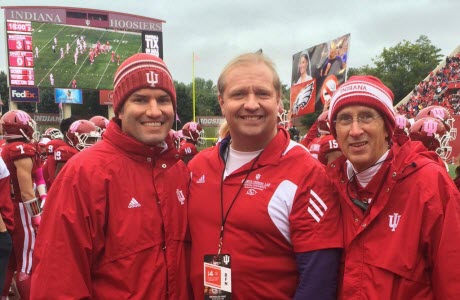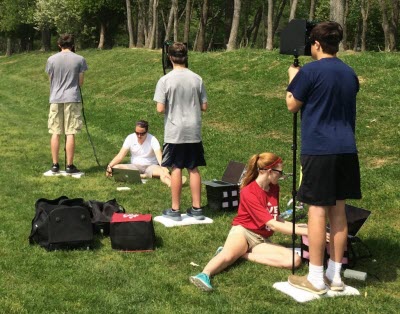Portable Tool Being Developed to Diagnose Concussions on the Sideline
To measure concussion symptoms, researchers devised a system that consists of eye-tracking goggles within a shoebox-sized device and a balance platform
 Dr. Andy S. Hipskind, Nicholas Port and Dr. Terry Horner, from left, at a recent IU football game.Photo courtesy of Indiana UniversityBLOOMINGTON, Ind. -- As Hollywood readies to weigh in on football's biggest quandary with the Christmas Day release of "Concussion," two Indiana University scientists continue their work toward a portable sideline device that will be able to quickly detect signs of mild brain trauma.
Dr. Andy S. Hipskind, Nicholas Port and Dr. Terry Horner, from left, at a recent IU football game.Photo courtesy of Indiana UniversityBLOOMINGTON, Ind. -- As Hollywood readies to weigh in on football's biggest quandary with the Christmas Day release of "Concussion," two Indiana University scientists continue their work toward a portable sideline device that will be able to quickly detect signs of mild brain trauma.
Since 2010, Nicholas Port and Steven A. Hitzeman, researchers at the IU School of Optometry, have gathered baseline data on the eye movements and balance of IU athletes and have since expanded their work to Bloomington North and South high schools and local club and youth sports. To help fund the sideline device, the duo received two two-year grants in 2014: $429,000 from the National Institutes of Health and a $120,000 award from the Indiana Spinal Cord and Brain Injury Research Fund.
To measure concussion symptoms, Port devised a system that consists of eye-tracking goggles within a shoebox-sized device and a balance platform based on technology in Nintendo's Wii gaming system. By comparing an athlete's baseline numbers with similar tests after a high-impact blow, the tester can quickly determine whether the athlete suffered a concussion and should be withheld from competition.
So far, data on more than 1,000 athletes–as well as 69 concussions–has been collected, about two-thirds of which came from football. Although there is not yet enough information to produce statistically valid conclusions, Port said, the data indicates that "some ocular and motor performance can be severely impaired during the acute phase of a concussion, which is the first 10 minutes to an hour after a concussion occurs. [So] when possible, we like to test the affected athlete within 10 minutes of the event."
Once fully developed, such technology could help eliminate scenarios such as what occurred in the Nov. 22 NFL game between the St. Louis Rams and the Baltimore Ravens, when Rams quarterback Case Keenum was sacked and hit his head on the turf. Despite the Rams sending their head trainer on the field to talk with Keenum, and the presence of an NFL injury spotter, Keenum remained in the game. He was sacked again two plays later and fumbled the ball. Only after the game was it found that Keenum had suffered a concussion.
 IU researchers conduct outdoor assessments of young athletes' eye movement and balance.Photo courtesy of Indiana University"The research being conducted will add an objective approach to this problem by developing a device that not only measures symptoms on-site but eliminates an athlete's ability to fool trainers, physicians and coaches into thinking they are fit to play," Port said.
IU researchers conduct outdoor assessments of young athletes' eye movement and balance.Photo courtesy of Indiana University"The research being conducted will add an objective approach to this problem by developing a device that not only measures symptoms on-site but eliminates an athlete's ability to fool trainers, physicians and coaches into thinking they are fit to play," Port said.
In some cases, athletes may not be aware they sustained a concussion until days later, says Orlin Watson, head athletic trainer for Bloomington North High School, which has had about 15 students take part in the study during the past two years.
"We explain to our student-athletes what it feels like to have a concussion and why it is important to report symptoms," Watson said. "But you're still dealing with subjective information. A device that can provide objective, unbiased information would serve as a valuable tool for athletic trainers in treating and diagnosing concussions."
Dr. Andy S. Hipskind, senior assistant athletic director for sports medicine and chief medical officer for IU Athletics, concurred: "A portable, on-site tool such as this will potentially benefit all athletes by taking some guesswork out of concussion management and prevent further possible injury through better decision-making on whether an athlete returns to playing in the immediate competition."
Though other scientists also explore concussions, the focus Port and Hitzeman place on the acute phase of concussive events puts them on the cutting edge of such research.
Next steps for Port and Hitzeman include applying for new grants, upgrading the data-collection units and then conducting clinical trials. Eventually, Port said, they hope to commercialize a "cheap, easy-to-use and portable" sideline tool for concussion diagnosis with the aid of the Indiana University Research and Technology Corp.
About the researchers:
Nicholas Port earned a PhD in neuroscience at the University of Minnesota and did his postdoctoral training at the National Eye Institute's Laboratory of Sensorimotor Research. His research into concussions began in 2005, when he joined the IU faculty and met Steven A. Hitzeman.
Steven A. Hitzeman is an associate professor emeritus of optometry. He has a longtime connection to IU Athletics that ranges from serving as a volunteer statistician to performing vision screenings for all IU athletes as team optometrist. His experience informed the research the pair are currently refining.
